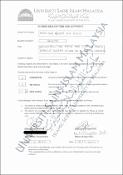Options
Reconstructing Rasm and Dabt in Pertis Braille Quran Based on Mushaf Al-Madinah
Date Issued
2023-02
Author(s)
Mohd Nur Adzam Rasdi
Abstract
The Holy Quran is narrated in two conditions, which include memorisation through talaqqi and musyafahah. Therefore, the standardisation of the Quran as a volume is pivotal in preserving the unity of the ummah, and in evidencing textual authenticity as a fundamental reference for Muslims. Since the scripting standardisation of the Holy Quran by Caliph Uthman, the religious scholars of the ummah have strived to maintain the form and writing system known as the Rasm Uthmani. However, the PERTIS Braille Quranic scripting system, is based on Rasm Imla'i. The dabt system is not as comprehensive as the dabt system applied in the volume typically used. The difference causes the visually impaired to be backward in their understanding and mastery in the knowledge of Quranic scripting. Moreover, an inclusive study and recitation of the Holy Quran between the visually impaired and the typical group are challenging, due to the different standards of the volumes. This study is based on four objectives. First, it aims to identify the need for the Braille Quranic volume to be standardised with the al-Madinah standardised mushaf, from the perspective of the visually impaired. Based on the realisation of such a need, the PERTIS Braille Quranic volume text was scrutinised along with the mushaf al-Madinah for standardisation, which is the second research objective. The third objective was to theoretically aline the application of rasm and dabt between the Braille Quranic texts and the mushaf al-Madinah text. After the theoretical coordination was completed, the study went on with the final objective, which is to develop the Braille Quranic text which has been coordinated with the mushaf al-Madinah volume text from the rasm and dabt perspectives. The study was qualitative in nature. The method used in the study needs phase was the interview. Findings from the semi-strucrured interview data were analysed using the N’Vivo version 8.0 software. Seven users of the PERTIS Braille Quranic volume were chosen as study participants through the purposeful sampling technique. The next data were obtained from the text analysis method. This process was to analyse the elements which required coordination from the mushaf al-Madinah text to the Braille Quranic text. The study found that there was a need for standardisation and redevelopment of the PERTIS Braille Quranic text based on the mushaf al-Madinah text. The most important element focused was on the standardisation of the rasm and dabt. After the redevelopment, the text of Sura al-Sajdah was completed as a study sample, with 515 adjustments in which 55 were standardisation in the rasm category, and 460 were from the dabt category. The study has produced a guide for the standardisation and development of the sacred verses of the Holy Quran in Braille based on the Rasm Uthmani and dabt. The findings of this study can be used as a guide by users, publishers and bodies such as PERTIS, LPPPQ (KDN), JAKIM and KPM, besides being able to create an inclusive unity among Muslims through the standardisation of Quranic text scripting.
File(s)

Loading...
Name
4140198 Declaration..pdf
Size
209.08 KB
Format
Adobe PDF
Checksum
(MD5):296e377ba6146d6491114f9010149160
Loading...
Name
4140198 Introduction.pdf
Size
1.99 MB
Format
Adobe PDF
Checksum
(MD5):5cc5bb71d1fa0603620858f3cb2364ea